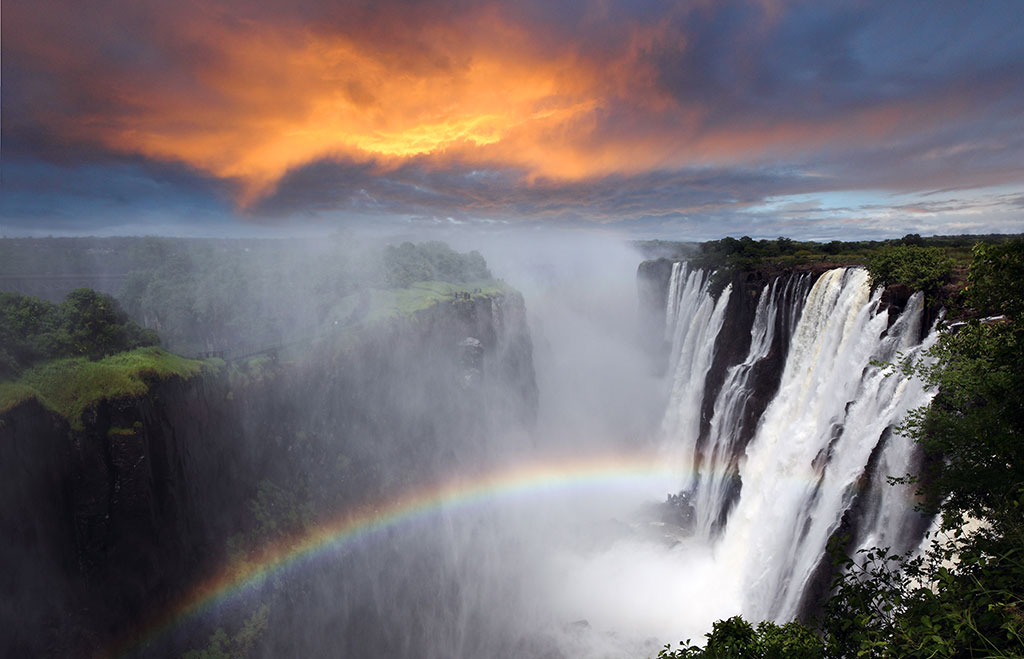THE CLIMATE IN ZAMBIA

Zambia has a sub-tropical climate that is tempered by its relatively high altitude, making it more temperate and pleasant than other sub-tropical areas. There are three distinct seasons:
November to April: Hot and rainy: frequent, intense showers followed by bright sunshine. Some roads and rivers become impassable while vegetation thrives.
May to August: Cooler and dry: frost may occur overnight in low-lying areas and winds can spark fires as the bush dries out.
August to November: Hot and dry: bushfires are not uncommon and non-permanent water sources dry up.

ANNUAL AVERAGE RAINFALL
While the rainfall pattern over the whole country is similar – most occur between November and March – the amount of rain varies considerably. The climate is affected by the movement of the intertropical convergence zone (ITCZ), which is the meeting place of the sub-tropical high-pressure areas of the northern and southern hemispheres. The zone moves southward with the apparent movement of the sun in the southern summer and brings rain to the greater part of Zambia. In the north, rainfall is 1 250mm / 50in or more a year, decreasing southwards to Lusaka where it is about 750mm / 30in annually. South of Lusaka rainfall is dictated by the easterly and southeast trade winds, which have lost much of their humidity by the time they have reached so far inland. Rainfall in this area is between 500-750mm / 20-30in.
In exceptional years the influence of the ITCZ is felt much farther to the south, resulting in excessive rain in the Southern Province and partial drought in the north. Except for very rare showers in August, rainfall is confined to the wet season, which sometimes starts as early as October and finishes as early as March. At the height of the wet season, it rains on seven or eight days out of 10. Average temperatures are moderated by the height of the plateau. There is occasional frost on calm nights in valleys that are sheltered from the wind. In the cool season the prevailing wind, a dry south-easterly, comes from the southern hemisphere belt of high pressure. An influx of cold air from the southeast brings cloudy to overcast conditions.
Zambia’s predominant vegetation is savanna and over half the country is covered by trees, varying from the more open conditions in the drier south to dense woodlands of hardwoods in the north and north-west. The trees are bare for a brief period only and the spring leaves appear before the start of the rains. Grass fires spread rapidly in the dry season but new blades of grass soon push through the blackened earth. Zambia’s climate makes possible the cultivation of a wide range of crops such as maize, tobacco, cotton, rice, wheat and groundnuts. All kinds of vegetables can be grown, together with citrus fruit, bananas, pineapples, mangoes, avocados and even grapes. Litchis are also a high-potential export crop. Tea and high-quality coffee are also grown successfully. Sugar cane is grown both by subsistence villagers and commercially.
RAINFALL AND TEMPERATURE TABLE FOR ZAMBIA
| Station | Altitude | Annual Rainfall | Mean Max Temp Oct | Mean Min Temp June | ||||
|---|---|---|---|---|---|---|---|---|
| metres | feet | mm | inches | °C | °F | °C | °F | |
| Mbala | 1633 | 5488 | 1140 | 45.58 | 28.2 | 82.4 | 10.6 | 51.0 |
| Kasama | 1380 | 4554 | 1240 | 49.69 | 31.9 | 88.9 | 10.1 | 50.2 |
| Mpika | 1393 | 4600 | 1110 | 44.52 | 30 | 85.7 | 10.1 | 50.1 |
| Mansa | 1178 | 3890 | 1050 | 42.02 | 32.6 | 90.2 | 6.8 | 44.2 |
| Mwinilunga | 1354 | 4470 | 1320 | 53.00 | 30.6 | 86.7 | 6.8 | 44.3 |
| Ndola | 1262 | 4167 | 1150 | 45.96 | 32.3 | 89.7 | 6.2 | 43.1 |
| Kabwe | 1200 | 3962 | 900 | 36.03 | 32.1 | 89.2 | 9.9 | 49.8 |
| Lusaka | 1272 | 4198 | 800 | 32.32 | 31.6 | 88.3 | 10.1 | 50.2 |
| Petauke | 1030 | 3398 | 950 | 37.86 | 33.1 | 91.1 | 12.3 | 53.9 |
| Chipata | 1024 | 3380 | 1000 | 39.84 | 32.6 | 90.3 | 12.3 | 53.9 |
| Mongu | 1047 | 3455 | 950 | 38.17 | 34.2 | 93.1 | 8.7 | 47.6 |
| Livingstone | 981 | 3236 | 740 | 29.79 | 34.8 | 94.2 | 7.1 | 44.6 |
